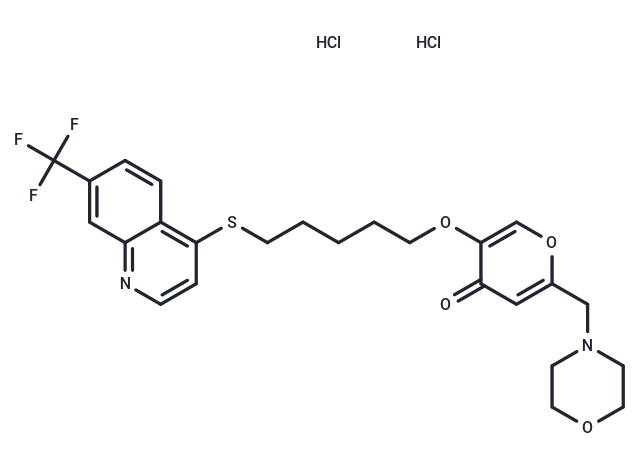Shopping Cart
- Remove All
 Your shopping cart is currently empty
Your shopping cart is currently empty

EHT 1864 (EHT 1864 2HCl) is a Rac family GTPase inhibitor that blocks activation by direct binding to Rac1, Rac1b, Rac2, and Rac3 (Kd=40/50/60/250 nM). EHT 1864 inhibits Rac, Ras, and Tiam-induced growth transformation of NIH-3T3 fibroblasts.

| Pack Size | Price | Availability | Quantity |
|---|---|---|---|
| 1 mg | $39 | In Stock | |
| 5 mg | $84 | In Stock | |
| 10 mg | $138 | In Stock | |
| 25 mg | $273 | In Stock | |
| 50 mg | $497 | In Stock | |
| 100 mg | $712 | In Stock | |
| 200 mg | $983 | In Stock | |
| 1 mL x 10 mM (in DMSO) | $109 | In Stock |
| Description | EHT 1864 (EHT 1864 2HCl) is a Rac family GTPase inhibitor that blocks activation by direct binding to Rac1, Rac1b, Rac2, and Rac3 (Kd=40/50/60/250 nM). EHT 1864 inhibits Rac, Ras, and Tiam-induced growth transformation of NIH-3T3 fibroblasts. |
| Targets&IC50 | Rac1:40 nM(Kd), Rac3:250 nM(Kd), Rac1b:50 nM(Kd), Rac2:60 nM(Kd) |
| In vitro | METHODS: U87-MG cells were treated with EHT 1864 (10-25 µM) for 5 min and the levels of activated Rac1 or RhoA were measured by pull-down. RESULTS: EHT 1864 strongly inhibited the ability of Rac1 to interact with its effector Pak1 in a dose-dependent manner. In contrast, EHT 1864 did not affect the activation state of RhoA even at the highest dose tested (25 µM). [1] METHODS: Mouse fibroblasts NIH 3T3 were treated with EHT 1864 (5 µM) for 4 h. Cultures were then stimulated with PDGF, LPA, or bradykinin for 15 min, fixed, and visualized for the actin filaments using Alexa phalloidin. RESULTS: PDGF, LPA and bradykinin were effective in inducing membrane wrinkling and lamellipodia formation, actin stress fibers and filamentous pseudopods, respectively. However, in the presence of EHT 1864, PDGF-induced lamellipodia formation was completely blocked, although LPA and bradykinin still induced their respective changes in actin cytoskeletal organization. EHT 1864-treated cells showed an approximately 80% reduction in lamellipodia stimulation by PDGF. [2] |
| In vivo | METHODS: To test the antitumor activity in vivo, EHT 1864 (100 mg/kg) was injected intraperitoneally twice daily for two weeks into NSG mice bearing BT-474 xenografts. RESULTS: EHT 1864 significantly slowed down tumor growth, with an average weekly growth rate of 50% vs. 27%. EHT 1864 greatly reduced the levels of P-ERK1/2, P-AKT, P-p70S6K, and P-Histone H3S10 (mitotic markers). [3] |
| Kinase Assay | Inhibitor:GTPase binding analyses: For inhibitor:GTPase binding analyses, aliquots of small GTPase solution (containing 1 μM inhibitor) are titrated into a solution of 1 μM inhibitor in the cuvette. Changes in fluorescence anisotropy are monitored at λex = 360 nm, λem = 440 nm, 30 s after each addition. All data analysis and curve fitting were performed using Microsoft Excel and QuantumSoft's ProFit for Mac OS X. |
| Cell Research | NIH 3T3 cells stably expressing oncogenic Ras are plated in 96-well plates. The cells are cultured for up to 4 days in complete growth medium, either alone, or supplemented with 5 μM EHT 1864. Cell growth is then assessed using the conversion of MTT to a formazan product. Briefly, the MTT reagent (from a 5 mg/ml solution diluted in PBS) is added to the wells at a final concentration of 0.5 mg/ml, and the cells are further incubated for 4 h at 37°C. The medium is then removed, and the reaction is terminated by adding 100 μl/well Me2SO. The absorbance is read at 570 nm using a microplate reader.(Only for Reference) |
| Molecular Weight | 581.47 |
| Formula | C25H29Cl2F3N2O4S |
| Cas No. | 754240-09-0 |
| Smiles | Cl.Cl.FC(F)(F)c1ccc2c(SCCCCCOc3coc(CN4CCOCC4)cc3=O)ccnc2c1 |
| Relative Density. | no data available |
| Storage | Powder: -20°C for 3 years | In solvent: -80°C for 1 year | Shipping with blue ice. | ||||||||||||||||||||||||||||||||||||||||
| Solubility Information | DMSO: 50 mg/mL (85.99 mM), Sonication is recommended. H2O: 58.2 mg/mL (100.09 mM), Sonication is recommended. | ||||||||||||||||||||||||||||||||||||||||
Solution Preparation Table | |||||||||||||||||||||||||||||||||||||||||
DMSO/H2O
H2O
| |||||||||||||||||||||||||||||||||||||||||

Copyright © 2015-2025 TargetMol Chemicals Inc. All Rights Reserved.